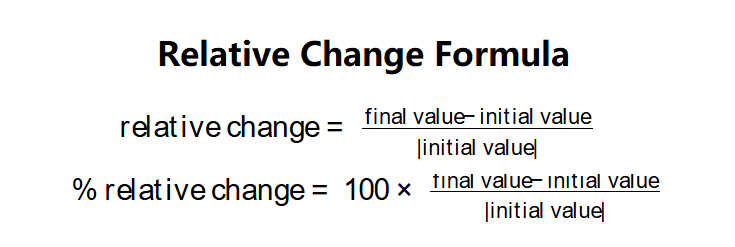1. What is the Relative Change Calculator?
Definition: This calculator computes the absolute change, the relative change (as a decimal), and the relative change percentage between an initial value and a final value. The relative change (decimal) is calculated as
\( \text{relative change} = \frac{\text{final value} - \text{initial value}}{|\text{initial value}|} \),
the relative change percentage is \( \% \text{ relative change} = 100 \times \frac{\text{final value} - \text{initial value}}{|\text{initial value}|} \), and the absolute change is \( \text{absolute change} = \text{final value} - \text{initial value} \).
Purpose: It helps users quantify the proportional difference between two values, both as a decimal ratio and as a percentage, alongside the absolute difference, useful in fields like finance, economics, physics, and statistics for tracking changes such as revenue growth or population changes.
2. How Does the Calculator Work?
The calculator uses the following equations:
- Absolute Change: \( \text{absolute change} = \text{final value} - \text{initial value} \)
- Relative Change (decimal): \( \text{relative change} = \frac{\text{final value} - \text{initial value}}{|\text{initial value}|} \)
- Relative Change (%): \( \% \text{ relative change} = 100 \times \frac{\text{final value} - \text{initial value}}{|\text{initial value}|} \)
Where:
- \( \text{initial value} \): The starting value;
- \( \text{final value} \): The ending value;
- \( |\text{initial value}| \): The absolute value of the initial value (to handle negative initial values).
Steps:
- Enter the initial value (e.g., the starting revenue).
- Enter the final value (e.g., the ending revenue).
- The calculator checks that the initial value is not zero to avoid division by zero.
- Calculate the absolute change by subtracting the initial value from the final value.
- Calculate the relative change (decimal) by dividing the absolute change by the absolute value of the initial value.
- Calculate the relative change percentage by multiplying the relative change (decimal) by 100.
- Display all results, formatted in scientific notation if the absolute value is less than 0.001, otherwise with 4 decimal places.
3. Importance of Relative Change Calculation
Calculating relative change (both as a decimal and percentage) and absolute change is crucial for:
- Financial Analysis: Measuring growth or decline in revenue, profit, or stock prices, with the decimal form useful for further calculations.
- Economic Indicators: Tracking changes in metrics like unemployment rates or inflation, with both absolute and relative perspectives.
- Scientific Experiments: Evaluating changes in measurements, where the decimal form can be used in formulas requiring ratios.
- Population Studies: Assessing population growth or decline rates, with percentage for interpretation and decimal for analysis.
4. Using the Calculator
Example 1 (Minimum Wage Increase): Calculate the relative change and absolute change when the minimum wage increases from $7/hr to $15/hr, as provided in the content:
- Initial Value: \( \text{initial value} = 7 \);
- Final Value: \( \text{final value} = 15 \);
- Absolute Change: \( \text{final value} - \text{initial value} = 15 - 7 = 8 \);
- Relative Change (decimal): \( \frac{15 - 7}{|7|} = \frac{8}{7} \approx 1.1429 \);
- Relative Change (%): \( 100 \times \frac{15 - 7}{|7|} = 100 \times \frac{8}{7} \approx 114.2857 \);
- Result: \( \text{absolute change} = 8.0000 \), \( \text{relative change} = 1.1429 \), \( \% \text{ relative change} = 114.2857\% \).
Example 2 (Vibrating Object Frequency): Calculate the relative change and absolute change for a vibrating object's frequency, where the theoretical frequency is 75 Hz and the measured frequency is 80 Hz, as provided in the content:
- Initial Value (Theoretical): \( \text{initial value} = 75 \);
- Final Value (Measured): \( \text{final value} = 80 \);
- Absolute Change: \( \text{final value} - \text{initial value} = 80 - 75 = 5 \);
- Relative Change (decimal): \( \frac{80 - 75}{|75|} = \frac{5}{75} \approx 0.0667 \);
- Relative Change (%): \( 100 \times \frac{80 - 75}{|75|} = 100 \times \frac{5}{75} \approx 6.6667 \);
- Result: \( \text{absolute change} = 5.0000 \), \( \text{relative change} = 0.0667 \), \( \% \text{ relative change} = 6.6667\% \).
5. Frequently Asked Questions (FAQ)
Q: What’s the difference between Relative Change and Relative Change %?
A: Relative Change is the decimal ratio of the change (\( \frac{\text{final} - \text{initial}}{|\text{initial}|} \)), while Relative Change % is the same value multiplied by 100 to express it as a percentage.
Q: What does a negative relative change mean?
A: A negative relative change (both decimal and percentage) indicates a decrease from the initial value to the final value (e.g., a decline in revenue).
Q: How precise are the results?
A: All results are displayed with 4 decimal places, or in scientific notation if the value is less than 0.001, ensuring high precision.
Relative Change Calculator© - All Rights Reserved 2025
 Home
Home
 Back
Back
